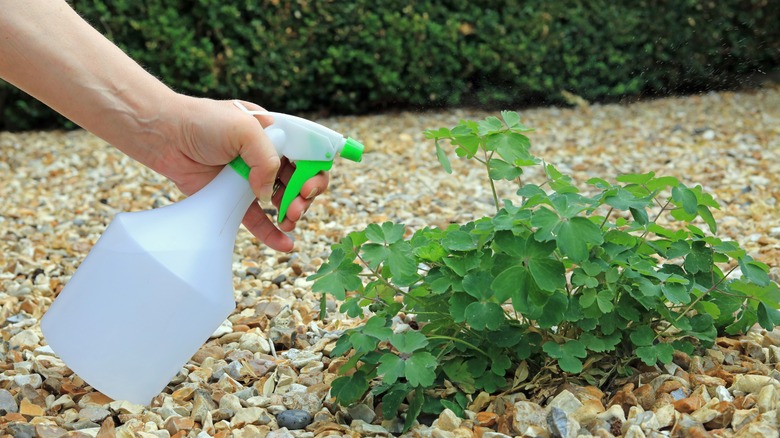Keep Weeds From Popping Up Between Cracks With An Item From Your Pantry
A pristine driveway or patio is a pleasure to look at. But how do you keep those pesky weeds from growing in the cracks? Weeds are often incredibly resilient, which can make it tempting to reach for a harsh weed killer off the bat. But weed killers can be full of harsh chemicals, and understanding all the different types of weed killer can be baffling. So rather than resorting to chemical solutions, why not try a natural alternative instead?
Vinegar is a natural weed killer that can be highly effective if used correctly. With a high acetic acid content, vinegar works by dehydrating weeds and is particularly efficient on new growth. Best of all, when used correctly, it's perfectly safe and nontoxic. You may already be familiar with all the ways vinegar can be a versatile cleaning tool in your home, but using it outside on weeds popping up between cracks requires a slightly different approach. Applying it without due care and attention could be detrimental to other plants and areas of your garden, and knowing what vinegar does to your grass is crucial. Plus, care needs to be taken around the percentage of acetic acid in your chosen vinegar. Bearing all this in mind, a little time spent preparing correctly is vital.
How to use vinegar to kill weeds growing in cracks
To make your own DIY weed killer, you'll need a few ingredients that will probably be easily found in your home. Combine 2 cups vinegar, 1 cup baking soda, and juice from five lemons into a large plastic jug. Mix this well together and fill a small spray bottle with the vinegar solution. If you need larger quantities, simply upsize in this ratio. Both white vinegar and apple cider vinegar have an acetic acid content between 4% and 8%, which is safe for humans to use without the risk of acid burns. The lemon juice contains citric acid, which helps to shrivel weeds.
Carefully spray the weeds in the cracks, making sure to completely saturate everything that's exposed. If you have plants nearby and are worried about the spray traveling toward them, you could use a paintbrush to paint the solution on, although this will obviously be far more time consuming. Wait several days, and you should be able to simply pluck the dead weed from the cracks. If there's any soil left behind, use a vacuum cleaner to remove as much as possible. You could also consider filling the cracks with masonry or asphalt caulk to avoid regrowth, although this may not match your aesthetics.
You might need to use a stronger solution for established weeds. Horticultural vinegar is 10% to 20% acetic acid, but any concentration over 11% carries the risk of burning the skin and causing serious eye injuries if it's splashed. It's therefore essential to wear protective clothing, gloves, and eye goggles, as well as being extremely careful when applying the vinegar.

